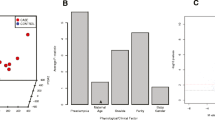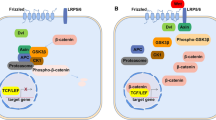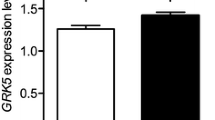Abstract
Preeclampsia is a placental vascular pathology and hypoxia is known to influence placental angiogenesis. Hypoxia Inducible Factors (HIF1α and HIF3α) mediate the response to cellular oxygen concentration and bind to hypoxia response element of target genes. However the mechanism regulating above activity is not well-understood. We investigated if placental DNA methylation (DNAm) and expression of HIF1α and 3α genes are altered and associated with pre-eclampsia, placental weight and birth outcomes. Using a cohort comprising women with preeclampsia [N = 100, delivering at term (N = 43) and preterm (N = 57)] and normotensive controls (N = 100), we analysed DNAm in HIF1α and 3α, and their mRNA expression in placentae, employing pyrosequencing and quantitative real-time PCR, respectively. We observed significant hypermethylation at cg22891070 of HIF3α in preeclampsia placentae compared to controls (β = 1.5%, p = 0.04). CpG8 in the promoter region of HIF1α, showed marginally significant hypomethylation in preterm preeclampsia compared to controls (β = − 0.15%, p = 0.055). HIF1α expression was significantly lower in preterm preeclampsia compared to controls (mean ± SE = 10.16 ± 2.00 vs 4.25 ± 0.90, p = 0.04). Further, DNAm in HIF1α promoter region was negatively associated with its expression levels (β = − 0.165, p = 0.024). Several CpGs in HIF1α were negatively associated with placental weight and birth outcomes including birth weight (β range = − 0.224–0.300) and birth length [β range = − 0.248 to − 0.301 (p < 0.05 for all)]. Overall, we demonstrate altered DNAm in HIF1α and HIF3α in preeclampsia placentae, also associated with various birth outcomes. Correlation of DNAm in HIF1α and its expression suggests a possible role in the pathogenesis of pre-eclampsia. Further investigations on interactions between HIF1α and HIF3α in preeclampsia would be interesting.



Similar content being viewed by others
Data availability
The study data will be available on request subject to approval from the Institutional Ethics Committee and Health Ministry Screening Committee, Govt of India. Methylation data have been placed on the server of the CSIR—Centre for Cellular and Molecular Biology (www.ccmb.res.in) in Hyderabad and can be accessed with permission from the authors.
References
Bokslag A, van Weissenbruch M, Mol BW, de Groot CJM (2016) Preeclampsia; short and long-term consequences for mother and neonate. Early Hum Dev 102:47–50. https://doi.org/10.1016/j.earlhumdev.2016.09.007
Jauniaux E, Gulbis B, Burton GJ (2003) The human first trimester gestational sac limits rather than facilitates oxygen transfer to the foetus—a review. Placenta 24(Suppl A):S86-93. https://doi.org/10.1053/plac.2002.0932
Patel J, Landers K, Mortimer RH, Richard K (2010) Regulation of hypoxia inducible factors (HIF) in hypoxia and normoxia during placental development. Placenta 31:951–957. https://doi.org/10.1016/j.placenta.2010.08.008
Qu H, Yu Q, Jia B et al (2021) HIF-3α affects preeclampsia development by regulating EVT growth via activation of the Flt-1/JAK/STAT signaling pathway in hypoxia. Mol Med Rep 23:68. https://doi.org/10.3892/mmr.2020.11701
Iriyama T, Wang W, Parchim NF et al (2015) Hypoxia-independent upregulation of placental hypoxia inducible factor-1α gene expression contributes to the pathogenesis of preeclampsia. Hypertension 65:1307–1315. https://doi.org/10.1161/HYPERTENSIONAHA.115.05314
Rajakumar A, Michael HM, Daftary A et al (2008) Proteasomal activity in placentas from women with preeclampsia and intrauterine growth restriction: implications for expression of HIF-alpha proteins. Placenta 29:290–299. https://doi.org/10.1016/j.placenta.2007.11.015
Ali LE, Salih MM, Elhassan EM et al (2019) Placental growth factor, vascular endothelial growth factor, and hypoxia-inducible factor-1α in the placentas of women with pre-eclampsia. J Matern Fetal Neonatal Med 32:2628–2632. https://doi.org/10.1080/14767058.2018.1443066
Dick KJ, Nelson CP, Tsaprouni L et al (2014) DNA methylation and body-mass index: a genome-wide analysis. Lancet 383:1990–1998. https://doi.org/10.1016/S0140-6736(13)62674-4
Pasanen A, Heikkilä M, Rautavuoma K et al (2010) Hypoxia-inducible factor (HIF)-3alpha is subject to extensive alternative splicing in human tissues and cancer cells and is regulated by HIF-1 but not HIF-2. Int J Biochem Cell Biol 42:1189–1200. https://doi.org/10.1016/j.biocel.2010.04.008
Li Y, Zhao X, He B et al (2021) Autophagy activation by hypoxia regulates angiogenesis and apoptosis in oxidized low-density lipoprotein-induced preeclampsia. Front Mol Biosci 8:709751. https://doi.org/10.3389/fmolb.2021.709751
Zhang Z, Huang C, Wang P et al (2020) HIF-1α affects trophoblastic apoptosis involved in the onset of preeclampsia by regulating FOXO3a under hypoxic conditions. Mol Med Rep 21:2484–2492. https://doi.org/10.3892/mmr.2020.11050
Korkes HA, De Oliveira L, Sass N et al (2017) Relationship between hypoxia and downstream pathogenic pathways in preeclampsia. Hypertens Pregnancy 36:145–150. https://doi.org/10.1080/10641955.2016.1259627
Kulkarni AV, Mehendale SS, Yadav HR et al (2010) Circulating angiogenic factors and their association with birth outcomes in preeclampsia. Hypertens Res 33:561–567. https://doi.org/10.1038/hr.2010.31
Sahay AS, Patil VV, Sundrani DP et al (2014) A longitudinal study of circulating angiogenic and antiangiogenic factors and AT1-AA levels in preeclampsia. Hypertens Res 37:753–758. https://doi.org/10.1038/hr.2014.71
Sundrani DP, Reddy US, Joshi AA et al (2013) Differential placental methylation and expression of VEGF, FLT-1 and KDR genes in human term and preterm preeclampsia. Clin Epigenetics 5:6. https://doi.org/10.1186/1868-7083-5-6
Dave KM, Kaur L, Randhir KN et al (2021) Placental growth factor and Fms related tyrosine kinase-1 are hypomethylated in preeclampsia placentae. Epigenomics 13:257–269. https://doi.org/10.2217/epi-2020-0318
Albers RE, Kaufman MR, Natale BV et al (2019) Trophoblast-specific expression of Hif-1α results in preeclampsia-like symptoms and Fetal growth restriction. Sci Rep 9:2742. https://doi.org/10.1038/s41598-019-39426-5
Sriyanti R, Mose JC, Masrul M, Suharti N (2019) The difference in maternal serum hypoxia-inducible factors-1α levels between early onset and late-onset preeclampsia. Open Access Maced J Med Sci 7:2133–2137. https://doi.org/10.3889/oamjms.2019.601
Galbiati S, Inversetti A, Causarano V et al (2015) HIF1A and MIF as potential predictive mRNA biomarkers of pre-eclampsia: a longitudinal prospective study in high risk population. Clin Chem Lab Med 53:1339–1347. https://doi.org/10.1515/cclm-2014-0745
Tal R (2012) The role of hypoxia and hypoxia-inducible factor-1alpha in preeclampsia pathogenesis. Biol Reprod 87:134. https://doi.org/10.1095/biolreprod.112.102723
Artavanis-Tsakonas S, Rand MD, Lake RJ (1999) Notch signaling: cell fate control and signal integration in development. Science 284:770–776. https://doi.org/10.1126/science.284.5415.770
Liu Z-J, Shirakawa T, Li Y et al (2003) Regulation of Notch1 and Dll4 by vascular endothelial growth factor in arterial endothelial cells: implications for modulating arteriogenesis and angiogenesis. Mol Cell Biol 23:14–25. https://doi.org/10.1128/MCB.23.1.14-25.2003
Cobellis L, Mastrogiacomo A, Federico E et al (2007) Distribution of Notch protein members in normal and preeclampsia-complicated placentas. Cell Tissue Res 330:527–534. https://doi.org/10.1007/s00441-007-0511-6
Løset M, Mundal SB, Johnson MP et al (2011) A transcriptional profile of the decidua in preeclampsia. Am J Obstet Gynecol 204:84.e1-84.e27. https://doi.org/10.1016/j.ajog.2010.08.043
Walczak-Drzewiecka A, Ratajewski M, Pułaski Ł, Dastych J (2010) DNA methylation-dependent suppression of HIF1A in an immature hematopoietic cell line HMC-1. Biochem Biophys Res Commun 391:1028–1032. https://doi.org/10.1016/j.bbrc.2009.12.011
Harati-Sadegh M, Kohan L, Teimoori B et al (2018) The association of the placental Hypoxia-inducible factor1-α polymorphisms and HIF1-α mRNA expression with preeclampsia. Placenta 67:31–37. https://doi.org/10.1016/j.placenta.2018.05.005
Tianthong W, Phupong V (2021) Serum hypoxia-inducible factor-1α and uterine artery Doppler ultrasound during the first trimester for prediction of preeclampsia. Sci Rep 11:6674. https://doi.org/10.1038/s41598-021-86073-w
Rolfo A, Many A, Racano A et al (2010) Abnormalities in oxygen sensing define early and late onset preeclampsia as distinct pathologies. PLoS ONE 5:e13288. https://doi.org/10.1371/journal.pone.0013288
Löfstedt T, Fredlund E, Holmquist-Mengelbier L et al (2007) Hypoxia inducible factor-2alpha in cancer. Cell Cycle 6:919–926. https://doi.org/10.4161/cc.6.8.4133
Tong W, Giussani DA (2019) Preeclampsia link to gestational hypoxia. J Dev Orig Health Dis 10:322–333. https://doi.org/10.1017/S204017441900014X
Saben J, Lindsey F, Zhong Y et al (2014) Maternal obesity is associated with a lipotoxic placental environment. Placenta 35:171–177. https://doi.org/10.1016/j.placenta.2014.01.003
Mansell T, Ponsonby A-L, Januar V et al (2019) Early-life determinants of hypoxia-inducible factor 3A gene (HIF3A) methylation: a birth cohort study. Clin Epigenet 11:96. https://doi.org/10.1186/s13148-019-0687-0
Mansell T, Burgner D, Ponsonby A-L et al (2020) HIF3A cord blood methylation and systolic blood pressure at 4 years—a population-based cohort study. Epigenetics 15:1361–1369. https://doi.org/10.1080/15592294.2020.1781027
Wang S, Song J, Yang Y et al (2015) HIF3A DNA methylation is associated with childhood obesity and ALT. PLoS ONE 10:e0145944. https://doi.org/10.1371/journal.pone.0145944
Pfeiffer S, Krüger J, Maierhofer A et al (2016) Hypoxia-inducible factor 3A gene expression and methylation in adipose tissue is related to adipose tissue dysfunction. Sci Rep 6:27969. https://doi.org/10.1038/srep27969
Héberlé É, Bardet AF (2019) Sensitivity of transcription factors to DNA methylation. Essays Biochem 63:727–741. https://doi.org/10.1042/EBC20190033
Sun D-G, Tian S, Zhang L et al (2020) The miRNA-29b is downregulated in placenta during gestational diabetes mellitus and may alter placenta development by regulating trophoblast migration and invasion through a HIF3A-dependent mechanism. Front Endocrinol (Lausanne) 11:169. https://doi.org/10.3389/fendo.2020.00169
Pan H, Lin X, Wu Y et al (2015) HIF3A association with adiposity: the story begins before birth. Epigenomics 7:937–950. https://doi.org/10.2217/epi.15.45
Maynard MA, Evans AJ, Hosomi T et al (2005) Human HIF-3alpha4 is a dominant-negative regulator of HIF-1 and is down-regulated in renal cell carcinoma. FASEB J 19:1396–1406. https://doi.org/10.1096/fj.05-3788com
Lucas ES, Dyer NP, Murakami K et al (2016) Loss of endometrial plasticity in recurrent pregnancy loss. Stem Cells 34:346–356. https://doi.org/10.1002/stem.2222
Guo H, Wang Y, Jia W, Liu L (2021) MiR-133a-3p relieves the oxidative stress induced trophoblast cell apoptosis through the BACH1/Nrf2/HO-1 signaling pathway. Physiol Res 70:67–78. https://doi.org/10.33549/physiolres.934506
Sperandio S, Fortin J, Sasik R et al (2009) The transcription factor Egr1 regulates the HIF-1alpha gene during hypoxia. Mol Carcinog 48:38–44. https://doi.org/10.1002/mc.20454
Suehiro J, Hamakubo T, Kodama T et al (2010) Vascular endothelial growth factor activation of endothelial cells is mediated by early growth response-3. Blood 115:2520–2532. https://doi.org/10.1182/blood-2009-07-233478
Kalna V, Yang Y, Peghaire CR et al (2019) The transcription factor ERG regulates super-enhancers associated with an endothelial-specific gene expression program. Circ Res 124:1337–1349. https://doi.org/10.1161/CIRCRESAHA.118.313788
Sheridan R, Belludi C, Khoury J et al (2015) FOXO1 expression in villous trophoblast of preeclampsia and fetal growth restriction placentas. Histol Histopathol 30:213–222. https://doi.org/10.14670/HH-30.213
Ohnishi S, Maehara O, Nakagawa K et al (2013) Hypoxia-inducible factors activate CD133 promoter through ETS family transcription factors. PLoS ONE 8:e66255. https://doi.org/10.1371/journal.pone.0066255
Rosmarin AG, Resendes KK, Yang Z et al (2004) GA-binding protein transcription factor: a review of GABP as an integrator of intracellular signaling and protein-protein interactions. Blood Cells Mol Dis 32:143–154. https://doi.org/10.1016/j.bcmd.2003.09.005
Wang L, Sun ZS, Xiang B et al (2018) Targeted deletion of Insm2 in mice result in reduced insulin secretion and glucose intolerance. J Transl Med 16:297. https://doi.org/10.1186/s12967-018-1665-6
Siatecka M, Bieker JJ (2011) The multifunctional role of EKLF/KLF1 during erythropoiesis. Blood 118:2044–2054. https://doi.org/10.1182/blood-2011-03-331371
Chiou S-H, Chen S-J, Chang Y-L et al (2011) MafA promotes the reprogramming of placenta-derived multipotent stem cells into pancreatic islets-like and insulin+ cells. J Cell Mol Med 15:612–624. https://doi.org/10.1111/j.1582-4934.2010.01034.x
Westerman BA, Poutsma A, Maruyama K et al (2002) The proneural genes NEUROD1 and NEUROD2 are expressed during human trophoblast invasion. Mech Dev 113:85–90. https://doi.org/10.1016/s0925-4773(01)00665-7
Jing J, Pu Y, Gingrich J, Veiga-Lopez A (2019) Gestational exposure to Bisphenol A and Bisphenol S leads to fetal skeletal muscle hypertrophy independent of sex. Toxicol Sci 172:292–302. https://doi.org/10.1093/toxsci/kfz198
Mandò C, De Palma C, Stampalija T et al (2014) Placental mitochondrial content and function in intrauterine growth restriction and preeclampsia. Am J Physiol Endocrinol Metab 306:E404-413. https://doi.org/10.1152/ajpendo.00426.2013
Ijomone OK, Shallie PD, Naicker T (2020) Oligodendrocytes death induced sensorimotor and cognitive deficit in N-nitro-L-arginine methyl rat model of pre-eclampsia. Neurochem Res 45:902–914. https://doi.org/10.1007/s11064-020-02969-5
Deng F-T, Ouyang W-X, Ge L-F et al (2015) Expression of lung surfactant proteins SP-B and SP-C and their modulating factors in fetal lung of FGR rats. J Huazhong Univ Sci Technol Med Sci 35:122–128. https://doi.org/10.1007/s11596-015-1400-y
Powers NR, Dumont BL, Emori C et al (2020) Sexual dimorphism in the meiotic requirement for PRDM9: a mammalian evolutionary safeguard. Sci Adv 6:eabb6606. https://doi.org/10.1126/sciadv.abb6606
Holdsworth-Carson SJ, Lim R, Mitton A et al (2010) Peroxisome proliferator-activated receptors are altered in pathologies of the human placenta: gestational diabetes mellitus, intrauterine growth restriction and preeclampsia. Placenta 31:222–229. https://doi.org/10.1016/j.placenta.2009.12.009
Huebner H, Hartner A, Rascher W et al (2018) Expression and regulation of retinoic acid receptor responders in the human placenta. Reprod Sci 25:1357–1370. https://doi.org/10.1177/1933719117746761
Zadora J, Singh M, Herse F et al (2017) Disturbed placental imprinting in preeclampsia leads to altered expression of DLX5, a human-specific early trophoblast marker. Circulation 136:1824–1839. https://doi.org/10.1161/CIRCULATIONAHA.117.028110
Gou J, Hu T, Li L et al (2019) Role of epithelial-mesenchymal transition regulated by twist basic helix-loop-helix transcription factor 2 (Twist2) in embryo implantation in mice. Reprod Fertil Dev 31:932–940. https://doi.org/10.1071/RD18314
Miyashita H, Sato Y (2005) Metallothionein 1 is a downstream target of vascular endothelial zinc finger 1 (VEZF1) in endothelial cells and participates in the regulation of angiogenesis. Endothelium 12:163–170. https://doi.org/10.1080/10623320500227101
Acknowledgements
We thank the pregnant women and their families' willingness to participate in the study and provide informed consent. We thank all members of Mother and Child Health department, Interactive Research School for Health Affairs (IRSHA), Bharati Vidyapeeth (Deemed to be) University and members of Genomic Research on Complex diseases group (GRC group), CSIR-CCMB, Hyderabad for helpful discussions and valuable insights.
Funding
The Indian Council of Medical Research—Centre for Advanced Research in Preeclampsia (ICMR-CAR; Grant No. 5/7/1069/13-RCH, dt. 31/03/2017), Ministry of Health and Family Welfare, Government of India, New Delhi, India, sponsored this study. CSIR-Centre for Cellular and Molecular Biology (CSIR-CCMB), Ministry of Science and Technology, Government of India, New Delhi, India, provided further additional funding.
Author information
Authors and Affiliations
Contributions
SJ and GRC conceived and designed the experiments. LK, DS and KD performed the experiments. LK, DS, KR, and KK analyzed the data. SM was involved in recruitment of women. SJ and GC contributed reagents/materials/analysis tools. LK, DS, SB, SJ and GRC wrote the paper and LK was a major contributor. All authors read and approved the final manuscript.
Corresponding authors
Ethics declarations
Competing interests
The authors declare no competing interests.
Ethical approval
The Bharati Vidyapeeth Medical College Institutional Ethics Committee gave approval to this study (Ethics no: BVDUMC/IEC/81A dated 11/04/2018), following which the study was undertaken.
Consent to participate
After receiving written informed consent, patients were recruited at Department of Obstetrics & Gynecology, Bharati Hospital, Pune.
Additional information
Publisher's Note
Springer Nature remains neutral with regard to jurisdictional claims in published maps and institutional affiliations.
Supplementary Information
Below is the link to the electronic supplementary material.
Rights and permissions
Springer Nature or its licensor (e.g. a society or other partner) holds exclusive rights to this article under a publishing agreement with the author(s) or other rightsholder(s); author self-archiving of the accepted manuscript version of this article is solely governed by the terms of such publishing agreement and applicable law.
About this article
Cite this article
Kaur, L., Sundrani, D., Dave, K. et al. Hypoxia Inducible Factors (HIF1α and HIF3α) are differentially methylated in preeclampsia placentae and are associated with birth outcomes. Mol Cell Biochem 478, 2309–2318 (2023). https://doi.org/10.1007/s11010-023-04661-y
Received:
Accepted:
Published:
Issue Date:
DOI: https://doi.org/10.1007/s11010-023-04661-y




